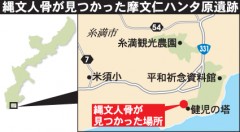Bone of tall Jomon man found in Itoman City

The Mabuni Hantabaru archeological site in Itoman, Okinawa, where the forearm bones of Jomon men were found.
August 31, 2011 Ryukyu Shimpo
At the Mabuni Hantabaru archeological site in Itoman City researchers have found a forearm bone of a male roughly 169 centimeters tall among the bones of 85 people from the late Jomon period, dating back 3,000-4,000 years.
The bone, measuring about 28 centimeters in length, is believed to be from a man who must have been extremely tall for the late Jomon period, since the average height of males of that period was only about 158 centimeters.

Takayuki Matsushita, honorary head of the Doigahama Site Anthropological Museum in Yamaguchi Prefecture, explains the place where the bone of a Jomon man was found in the Mabuni Hantabaru archeological site in Itoman City in July 2009.
Even on a national scale, it is very rare to discover a bone of such a tall Jomon man. It is the first time that the 169-centimeter estimated height of the person is found in Kyushu, Ymaguchi and Okinawa.
Matsushita said, “Although it is still unclear as to whether the bone belongs to a man who evolved from the Minatogawa Man, a prehistoric inhabitant of Okinawa, or a Jomon man, who came down from the Kyushu area to Okinawa, it is definitely a valuable discovery in terms of research on people from the Jomon period.”
According to Matsushita, the thickness of the bone and its development indicates that it was from a sturdy person of muscular build. The ulna was discovered in perfect shape along with the radius.
The museum conducted the excavation of the five square meter site in Itoman in collaboration with the Itoman Municipal Board of Education from July 2007 to July 2010.
The ulna of another male estimated to have been 164 centimeters tall have also been unearthed at the site. The bones reveal that these two men were the tallest of the people whose remains were discovered in the site.
Among the 85 sets of bones unearthed in the site, there were 32 male adults along with 31 female adults, six infants and nine children, as well as seven sets that could not be categorized for age at the time of death.
The site is a burial ground, where all the bones were collected in once place.
The researchers unearthed 230 incunabula, of which 80 percent were shell products, including rare items such as perforated modified tridacna plate-like products.
The Doigahama Site Anthropological Museum intends to announce the results of its survey at the 17th Doigahama Symposium in Shimonoseki, Yamaguchi Prefecture, on September 3.
(English Translation by T&CT, Mark Ealey)
Previous Article:Okinawa’s population estimated to exceed 1.4 million
Next Article:Three performers of Okinawan origin win the top awards in the Ryukyu Classical Art Contest
[Similar Articles]
- Japan’s oldest shell tools found in Sakitari Cave in Okinawa
- Three remains from the Battle of Okinawa found in Nishihara
- Human bones and stone tools dating back 12000 years found in Nanjo
- 9,000-10,000-year-old bone fragments discovered in Okinawa thought to be missing link between Paleolithic and Kaizuka-era humans
- Prehistoric Miyako people are a 100% DNA match with Jomon people, contrary to theory
 Webcam(Kokusai Street)
Webcam(Kokusai Street)


